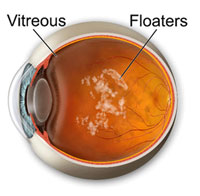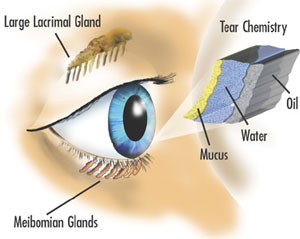Other Conditions
 There are many other eye conditions that can affect your eyes. Here are few more topics that you may be interested in:
There are many other eye conditions that can affect your eyes. Here are few more topics that you may be interested in:
- Flashes and Floaters
- Dry Eyes
- Eye Injuries
Flashes and Floaters: What You Need to Know
The eye is filled with a clear jelly called the vitreous gel. The vitreous gel inflates the back part of the eye in the way that water inflates a water balloon. As we age, the vitreous gel begins to dissolve into a more watery form. Once enough of the vitreous gel has dissolved - usually when we are in our late 50's or early 60's - the gel pulls free of its attachments to the back of the eye. This sudden and often dramatic event - called a posterior vitreous detachment - often causes a number of symptoms that can be alarming.
One common symptom of a posterior vitreous detachment is the appearance of floaters. Floaters are exactly what they sound like - tiny bits of debris that appear when the vitreous gel separated from the back of the eye. These bits of cloudy debris float in the liquefied vitreous like snow in a snow globe. If you have a single small floater, you may have the sensation that a bug is flying in your face. Often in eyes with posterior vitreous detachments, the floaters are bigger and somewhat stringy, and you may describe it as a spider web or cobweb in your vision. Typically, these floaters will move around in your vision, especially when you move your eyes around. Floaters usually do not stay in exactly the same spot in your vision.
Another common symptom of a posterior vitreous detachment is seeing flashing lights in the very periphery of your vision. As the vitreous gel pulls loose from the back of the eye, it tugs on the wallpaper lining the back of the eye. This wallpaper is called the retina. The retina is a thin layer and is like the film of a camera-it is the light-sensing part of the eye. When the retina is tugged on, it generates the sensation of flashing lights in the periphery of your vision.
Floaters are often annoying but not usually a threat to vision. But flashing lights can be a more worrisome sign. Sometimes when the vitreous tugs on the retina as it is pulling loose, it can pull so hard that it makes small rips or tears in the retina. The liquefied vitreous can then pass through the hole and cause the retina to come loose from the back of the eye as well. This is called a retinal detachment. If you have a retinal detachment, you may notice sections of your vision disappearing, as if a curtain or veil is covering parts of your vision. A retinal detachment is an emergency and often requires surgery to repair.
If you have the sudden onset of new floaters in your vision and/or flashing lights in the periphery of your vision, call your eye doctor immediately to arrange a prompt examination. During this examination, your pupils will be dilated to examine your retina to make sure there is no retinal detachment. While they are uncommon, retinal detachments can cause vision loss, and repairing them quickly is the best way to save your vision.
Dry Eyes
 Do you have dry eyes? Up to 12 million Americans suffer from a disease called dry eye syndrome. People with dry eyes frequently experience burning and stinging of their eyes, their eyes often feel sticky, and their eyes are often red. Some people with dry eyes also have periods when their eyes get so watery that tears spill over their eyelids and run down their cheeks.
Do you have dry eyes? Up to 12 million Americans suffer from a disease called dry eye syndrome. People with dry eyes frequently experience burning and stinging of their eyes, their eyes often feel sticky, and their eyes are often red. Some people with dry eyes also have periods when their eyes get so watery that tears spill over their eyelids and run down their cheeks.
Your eyes normally make small amounts of tears all day long. Tears play several important roles in keeping your eyes healthy and your vision clear. Tears lubricate the eye's surface, wash away debris, provide a smooth surface to help keep your vision clear, and also contain natural antibiotics that keep your eyes safe from germs that might cause infections.
Tears coat the eye in a smooth film made up of three separate layers, the mucin layer, the aqueous layer, and the lipid layer. Each layer of the tear film is made by a different part of the eye. The mucin layer is made by the eye surface itself. The aqueous layer is made by a tear gland tucked under the upper eyelid. And the lipid layer is made by small glands in the eyelids. For the tear film to do its job, all three layers have to be in their proper places in the correct amounts, like a recipe. If any layer is missing or abnormal-which can happen for a number of reasons-the tear film becomes disorganized and no longer soothes the eye like it should.
When that happens, the symptoms of dry eye syndrome occur. The front surface of the eye gets dried out (causing stickiness) and gets inflamed (causing stinging and burning). Once it gets inflamed, the eye ignores the proper tear film recipe and starts making large quantities of the aqueous layer in an effort to soothe itself. These bad tears don't soothe the eye at all-they just run down your face, washing away the mucin and lipid layers as well. This makes the eye even more irritated, so it makes even more bad tears, and the cycle continues.
For some people, the stinging and burning and redness and watering may seem like little more than a nuisance, but in fact, if left untreated, dry eye syndrome can lead to serious eye problems, including blindness. Dry eyes are inflamed eyes. Inflammation of the front surface of the eye increases the risk of some infections, and can also lead to scarring. Once scarring occurs, permanent loss of sight can occur.
If you have symptoms of dry eye syndrome, ask your doctor for a dry eye evaluation. Treatments are available to halt the disease and save your sight.
Eye Injuries
Eye injury is one of the leading causes of blindness. Dr. Militello is available to treat a wide range of eye injuries, including:
- Blunt trauma
- Corneal abrasion
- Chemical eye injuries
- Eyelid lacerations
- Foreign bodies
If you have an eye injury, seek medical care immediately.